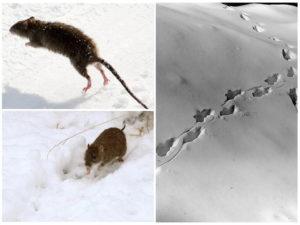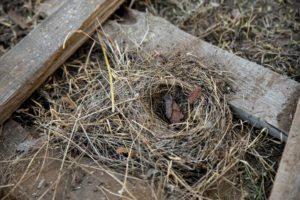How to examine and distinguish between mouse and rat tracks
Rats are classified as dangerous mammals. They spoil products, electrical wiring, building materials. Rodents can easily cope with any wooden structure and foam. Their nests can be found on the tracks in the snow.
Content
The structure of the paws of rats
The most common rat is the pasyuk, whose traces are very similar to all mouse-like ones. However, the paws are slightly larger.
The size of the trace of rats reaches a size of 2 * 1,5 cm. The fingers are up to 10 mm long, ending in short sharp claws. If the prints are clear, the plantar tubercles will be visible perfectly.
On a large print 4 cm in size, only the front half can be traced. All 5 fingers are visible, lateral ones protrude.
Rat paw prints depending on the mode of movement
In a dark room, the traces of a rat are located in pairs and sequentially. On one side, the print of the front and hind paws, then in the same sequence on the other side. There is a feeling that the animal is sneaking along a string.
Ricochet jumps - when the rat pushes off with its front paws, then with its hind legs, and lands on its front legs. Another type of jumping is when the rat groups the body like a spring, pushes off with its hind legs and brings them in front of the front ones.
The clearest traces are visible in the snow. Pasyuk's unhurried gait leaves traces at large intervals. They look splayed out.
Features of the movement of rats in winter
It is in the snow that the paw prints of rats are easiest to recognize. The type of movement of rodents depends on the height of the snow cover.
In the snowdrifts
In the snowdrifts, the rat jumps, but the depth of the snowdrifts creates obstacles. In this regard, the traces themselves change.
The interval decreases to 20 - 40 cm. The track is about 7 cm. Traces of the tail are visible. With large snowdrifts, it jumps 1 time to dive thoroughly and start making a move. It's like a trench. The prints are almost invisible.
In shallow snow
In such conditions, the rodent has several ways to move. The most common is jumps. The push is done with the front paws, and then with the back. This promotes body elongation and grouping.
https://youtu.be/xgkCaqYok7A
The structure of the paws of mice
The front fingers are four-fingered, the fifth is reduced. Hind feet with five toes, each of which ends in a small sharp nail.
Mouse paw prints
Mice get along well with people in the city and in the villages. They prefer to feed on seeds and vegetative parts of plants. Near people, they like to spoil cereals, dairy products, stocks of meat products.
There is nowhere to see their traces in the house, unless, of course, there is a layer of dust. In the barn and on the street, they can be tracked. Although, depending on the type of mouse, the signs may differ slightly, there are common signs.
Features of mouse traces depending on the type of movement
How to find a rodent nest by following their tracks
Following the route, you can find a nest. Pasyukov traces are clearer, but the distance is greater between them. They hold their paws tighter. In wood mice and voles, markings are not so clear and are closer.
Places where nests are located are covered with fallen leaves or rubbish. The diameter of the entrance is up to 5 cm. It is easy to check whether rodents live there. It is necessary to roll up the newspaper and place it in the hole. After pulling out the crumpled and splattered paper in a day, it becomes clear that there are inhabitants inside and it is necessary to take measures to destroy it.
Conclusion
Without experience, it is difficult to determine the traces of a rat. Rodents can control the distance of steps and the depth of pressing the paws. However, with the help of an accurate description of the markings, pest nests can be found.

